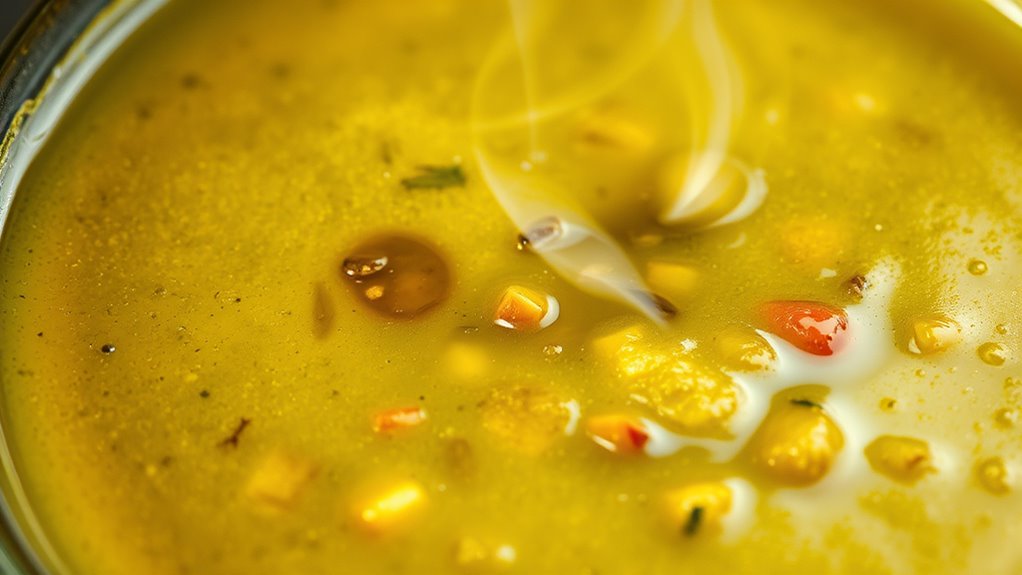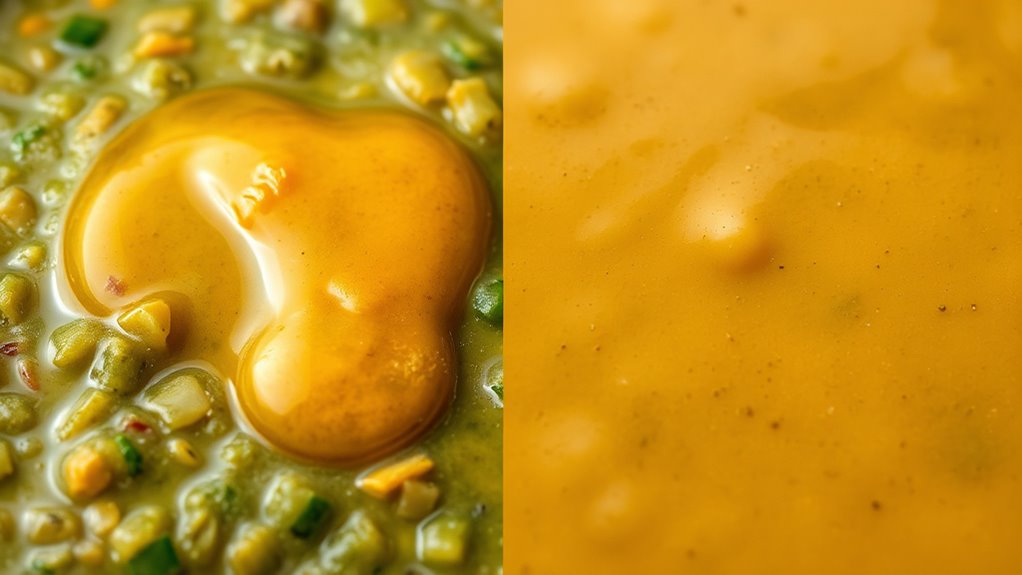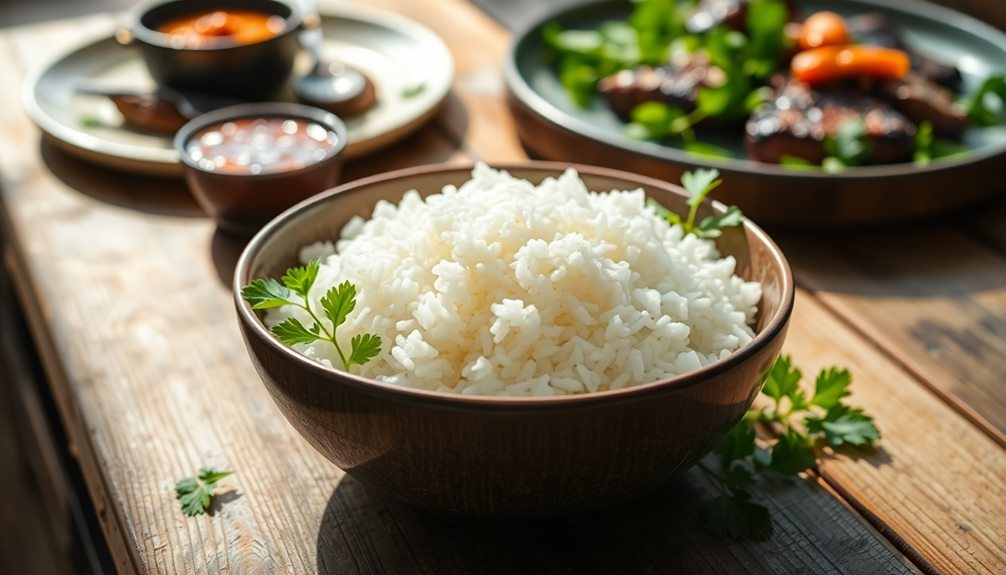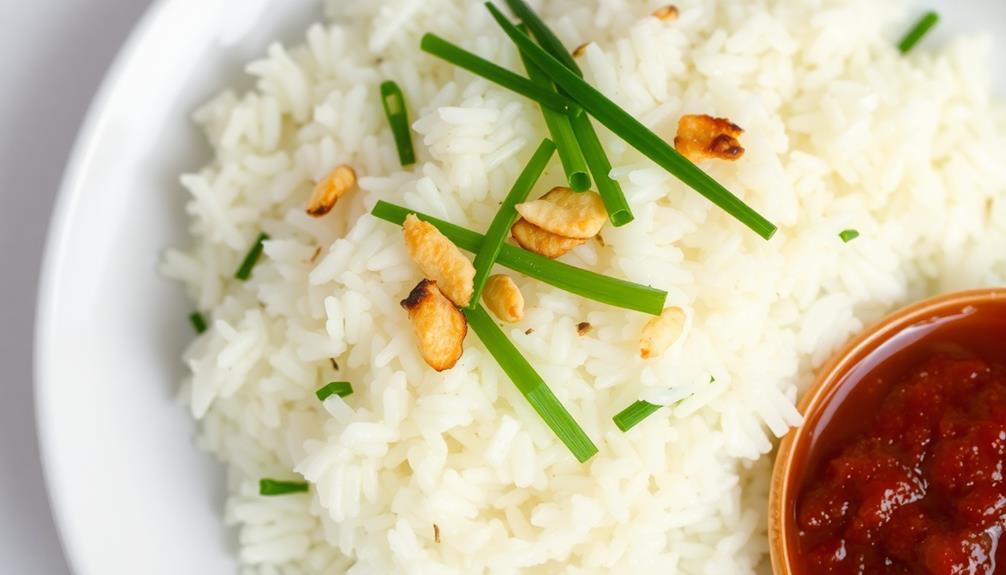In Nigerian egusi soup, oil separation happens when the oil isn’t properly emulsified or ingredients aren’t well combined, leading to a visible oily layer on top and a less cohesive texture. Emulsification involves gradually mixing ground egusi and oil while stirring vigorously to keep everything smooth and integrated. Managing temperature and stirring consistently helps prevent separation and creates that rich, creamy consistency you want. Keep exploring how these techniques can elevate your soup’s flavor and look.
Key Takeaways
- Oil emulsion in egusi soup results in a smooth, integrated appearance, while separation leaves a visible oil layer on top.
- Proper emulsification involves gradual mixing and vigorous stirring to blend oil evenly with other ingredients.
- Oil separation occurs when emulsions break down due to high heat, insufficient mixing, or rapid ingredient addition.
- Maintaining moderate heat and consistent stirring helps preserve emulsion stability and prevents oil separation.
- Personal preferences influence whether a soup shows visible oil or a well-emulsified, cohesive texture.

Egusi soup is a beloved Nigerian dish known for its rich flavor and hearty texture. When preparing this dish, one of the key factors that influence its quality is how you handle the oil during cooking. Whether your goal is to achieve a well-blended emulsion or to prevent oil separation, understanding oil stability and flavor retention is essential. Oil stability refers to how well the oil maintains its structure without breaking apart or separating from the other ingredients. A stable oil mixture ensures your soup remains creamy and cohesive, rather than oily or greasy on the surface. Flavor retention is equally important because the oil acts as a carrier for the flavors of spices, vegetables, and meat, helping them meld into a harmonious taste. If the oil separates, you risk losing this flavor infusion, resulting in a less savory dish.
Properly emulsifying oil ensures rich flavor and smooth texture in egusi soup.
When cooking egusi soup, you might notice that sometimes the oil tends to separate from the rest of the ingredients, forming a layer on top. This separation often occurs because the oil hasn’t been properly emulsified or because the ingredients haven’t been combined in a way that promotes oil stability. To prevent this, you need to pay attention to the cooking process. For instance, adding the ground egusi and oil mixture gradually while stirring vigorously can help create a stable emulsion. This method encourages the oil to blend smoothly with the other ingredients, trapping flavor molecules and creating a consistent, thick soup. Maintaining a good emulsion not only enhances the soup’s texture but also helps retain that rich, savory flavor you desire. Additionally, controlling the temperature during cooking is vital, as heat fluctuations can destabilize emulsions. Temperature control is crucial for maintaining a stable mixture and preventing separation.
On the other hand, if you prefer a more traditional look with visible oil separation, you might choose to add oil at different stages or allow it to float on the surface. While this can sometimes enrich the flavor, it might reduce overall flavor retention since the oil isn’t fully integrated. It’s a matter of personal preference, but generally, achieving a stable emulsion improves both the texture and taste of your egusi soup. Proper heat control also plays a role; too high heat can break down the emulsion, causing oil to separate, while moderate heat helps maintain stability. Incorporating emulsification techniques can help you better manage this process and achieve a consistent result. Using the right techniques can also prevent the oil from breaking apart during cooking.
In the end, whether you aim for a well-emulsified, creamy consistency or a more separated oil layer, understanding how to manage oil stability allows you to craft a delicious egusi soup that captures both the authentic flavor and the desired texture. It’s all about controlling the cooking process to preserve that rich flavor and ensure your soup turns out perfect every time. Mastery of emulsion techniques can significantly elevate the quality of your dish, making it more appealing both visually and gastronomically. This knowledge is especially valuable because it helps you adapt to different preferences and cooking styles.
Frequently Asked Questions
How Does the Type of Palm Oil Affect Emulsion Stability?
You wonder how palm oil varieties impact emulsion stability. Different types of palm oil, like red or refined, contain varying levels of natural emulsifiers and fatty acids, which influence how well your mixture stays combined. Red palm oil, rich in antioxidants and natural emulsifiers, generally offers better emulsion stability, preventing oil separation. Refined palm oil may be less stable. So, choosing the right palm oil variety helps maintain a consistent, stable emulsion.
Can Adding Water Influence the Oil Separation Process?
Imagine your soup as a delicate dance, where water addition acts like a guest stirring the rhythm. When you add water, it interacts with ingredients, disrupting the oil’s harmony and causing separation. Water can weaken the emulsion, making the oil more likely to separate from the rest of the ingredients. So, to keep the unity, add water carefully, understanding that ingredient interaction plays a vital role in maintaining stability.
Does the Cooking Duration Impact Emulsion Formation?
You might wonder if cooking duration affects emulsion formation. Longer cooking can help stabilize the mixture, allowing the oil and water to combine more effectively. As you cook, the heat breaks down ingredients, encouraging the formation of a stable emulsion. However, overcooking can cause the emulsion to break, leading to oil separation. So, paying attention to cooking duration is key to achieving a smooth, well-emulsified dish.
Are There Specific Ingredients That Promote or Prevent Oil Separation?
Think of your ingredients like a team in a dance. Some, like ground melon seeds, promote a stable emulsion by encouraging ingredient interactions that keep oil and water together. Others, like excess water or certain vegetables, can cause oil separation. By choosing your ingredients wisely, you preserve flavor and maintain a smooth, unified texture. So, yes, specific ingredients markedly influence whether your dish stays emulsified or oil separates.
How Does Temperature Alter the Emulsion or Separation in Egusi Soup?
Temperature effects markedly influence emulsion stability in your egusi soup. When you heat it, the emulsion becomes less stable, causing oil to separate more easily. Lower temperatures help maintain a smoother, more stable emulsion by slowing down the separation process. To keep your soup creamy and well-blended, avoid overheating and serve it at moderate temperatures, ensuring the emulsion stays intact and prevents unwanted oil separation.
Conclusion
Now, as you ladle the rich, creamy egusi soup, imagine the smooth embrace of a perfectly balanced emulsion, where oil and solids dance in harmony. Or picture a clear, oily layer gently settling atop, revealing a separation like the quiet end of a storm. Whether you prefer the velvety unity or the distinct layers, understanding this dance helps you master the art of Nigerian egusi soup, turning each spoonful into a flavorful masterpiece you can confidently serve.









